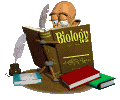| Chapter
Objectives
- List characteristics
that distinguish plants from other organisms in other kingdoms
- Diagram a generalized
plant life cycle indicating which generation is the sporophyte
or gametophyte, which are haploid or diploid, and where meiosis
and mitosis occur
- Describe 4 major periods
of plant evolution that opened up new adaptive zones on land
- Distinguish between
division and phylum
- Using the classification
scheme in your text list the plant divisions, give the common
name for each division, and categorize the groups into nonvascular,
vascular seedless, and vascular seed plants
- Provide evidence to
defend the position that plants evolved from green algae
- Describe 2 adaptations
that made a bryophyte move onto land possible
- Explain how Bryophytes
are still tied to water
- List and distinguish
among the 3 groups of Bryophytes
- Diagram the life cycle
of a moss, including gamete production, fertilization, and
spore production
- Compare environmental
conditions faced by algae in an aquatic environment and plants
in a terrestrial environment
- Provide evidence that
suggests Bryophyta is a phylogenetic branch separate from
vascular plants
- Describe adaptations
of vascular plants, including life cycle modifications and
sporophyte modifications that have contributed to their success
on land
- List and distinguish
among the 4 extant groups of seedless vascular plants
- Distinguish between
homosporous and heterosporous
- Distinguish among spore,
sporophyte, sporophyll, and sporangium
- Diagram the life cycle
of a fern including spore production, gamete production, and
fertilization
- Point out the major
life cycle differences between mosses and ferns
- Describe how coal is
formed and during which geological period the most extensive
coal beds were produced
****************************
- Describe the adaptations
of seed plants that have contributed to their success on land
- List the 4 groups of
Gymnosperms
- Describe and distinguish
between the structures of ovulate and pollen cones of a pine
- Describe the life history
of a pine and indicate which structures are part of the gametophyte
generation and which are part of the sporophyte generation
- Point out the major
life cycle differences in ferns and pines
- Distinguish between
pollination and fertilization
- Describe a pine seed
and indicate which structures are old sporophyte, gametophyte,
and new sporophyte
- Describe how the needle-shaped
leaves of pines and firs are adapted to dry conditions
- Compare the life cycles
of mosses, ferns, conifers, and flowering plants n terms of
- dominant life cycle
stage (sporophyte or gametophyte)
- homosporous or heterosporous
spore production
- gamete transfer
mechanism
- Describe refinements
in vascular tissue that occurred during angiosperm evolution
- Explain how the evolution
of the flower enhanced the reproductive efficiency of angiosperms
- Identify the following
floral structures and describe a function for each
- sepals
- petals
- stamens
- carpels
- filament
- anther
- stigma
- style
- ovary
- Describe 4 commonly
recognized evolutionary trends in floral structure found in
various angiosperm lineages
- Define fruit and explain
how fruits are modified in ways that help disperse seeds
- Diagram the generalized
life cycle of an angiosperm, identify which structures are
haploid, and explain how it differs from the life cycle of
a pine
- Explain the process
of double fertilization and describe the fate of the polyploid
nucleus
- Explain how an angiosperm
seed differs from that of a pine
- Explain why paleobotanists
have difficulty piecing together the origin of angiosperms
and describe some current theories on how flowering plants
may have evolved
- Explain how animals
may have influenced the evolution of terrestrial plants and
vice versa
|
| Chapter
Terms:
| Chapter
29 Terms |
| stomata
cuticle
secondary products
lignin
sporopollenin
gametangia
embryophyte
gametophyte
sporophyte
vascular tissue |
gymnosperm
angiosperm
division
charophyte
antheridium
archegonium
sporangium
mosses
liverworts
hornworts |
xylem
phloem
homosporous
heterosporous
megaspores
microspores
lycophytes
epiphytes
sporophylls
horsetails
ferns |
| |
| nucellus
integuments
ovule
seed
conifer
tracheids
vessel elements
fiber
flower |
sepal
petal
stamen
carpel
filament
anther
stigma
style
ovary |
fruit
pollen grains
embryo sac
cross-pollination
double fertilization
cotyledons
endosperm
coevolution |
|
| Chapter
Outline Framework
- An Overview of Plant
Evolution
- Structural, chemical,
and reproductive adaptations enabled plants to colonize
land
- The history of terrestrial
adaptation is the key to modern plant diversity
- Origins of Plants
- Plants probably
evolved from green algae called charophytes
- Alternation of generations
in plants may have evolved from delayed meiosis
- Adaptations to shallow
water may have preadapted plants for life on land
- Bryophytes
- Embryophyte adaptation
evolved in bryophytes
- Gametophyte is dominant
generation
- Mosses, liverworts,
hornworts
- Origin of Vascular
Plants
- Additional terrestrial
adaptations evolved as vascular plants descended from
bryophyte-like ancestors
- Branched sporophytes
of vascular plants amplified the production of spores
and made complex bodies possible
- Seedless Vascular
Plants
- A sporophyte-dominant
life cycle evolved in seedless vascular plants
- Lycophytes, horsetails,
ferns
- Seedless vascular
plants formed vast coal forests during the Carboniferous
period
- Overview of Reproductive
Adaptations of Seed Plants
- Gametophytes of
seed plants became even more reduced than the gametophytes
of seedless vascular plants
- Seed replaces spore
as main means of dispersing offspring
- Pollen becomes vehicle
for sperm cells in seed plants
- Gymnosperms
- Age of Gymnosperms
= Mesozoic
- Cycads, ginkgo,
gnetophytes, conifers
- Pine life cycle
is representative of key reproductive adaptations of seed
plants
- Angiosperms (Flowering
Plants)
- Terrestrial adaptation
continued with refinement of vascular tissue in angiosperms
- Flower is defining
reproduction adaptation of angiosperms
- Fruits help disperse
angiosperm seeds
- Angiosperm life
cycle is highly refined version of alternation of generations
common to all plants
- Radiation of angiosperms
marks transition from Mesozoic to Cenozoic
- Angiosperms and
animals have shaped each others evolution
- Agriculture is based
almost entirely on angiosperms
- Global Impact of
Plants
- Transform atmosphere
and climate
- Plant diversity
is a nonrenewable resource
back
to top |
|

